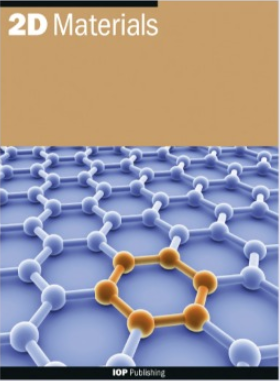Monolayer WS2 electro- and photo-luminescence enhancement by TFSI treatment
IF 4.3
3区 材料科学
Q2 MATERIALS SCIENCE, MULTIDISCIPLINARY
引用次数: 0
Abstract
Layered material heterostructures (LMHs) can be used to fabricate electroluminescent devices operating in the visible spectral region. A major advantage of LMH-light emitting diodes (LEDs) is that electroluminescence (EL) emission can be tuned across that of different exciton complexes (e.g. biexcitons, trions, quintons) by controlling the charge density. However, these devices have an EL quantum efficiency as low as~10−4%. Here, we show that the superacid bis-(triuoromethane)sulfonimide (TFSI) treatment of monolayer WS2-LEDs boosts EL quantum efficiency by over one order of magnitude at room temperature. Non-treated devices emit light mainly from negatively charged excitons, while the emission in treated ones predominantly involves radiative recombination of neutral excitons. This paves the way to tunable and efficient LMH-LEDs.通过 TFSI 处理增强单层 WS2 的电致发光和光致发光
层状材料异质结构(LMH)可用于制造在可见光谱区工作的电致发光器件。层状材料异质结构发光二极管(LED)的一个主要优点是可以通过控制电荷密度来调节不同激子复合物(如双激子、三激子、五激子)的电致发光(EL)发射。然而,这些器件的电致发光量子效率低至~10-4%。在这里,我们展示了对单层 WS2-LED 进行超酸性双(三氟甲烷)磺酰亚胺(TFSI)处理后,在室温下可将 EL 量子效率提高一个数量级以上。未经处理的器件主要通过带负电荷的激子发光,而经过处理的器件则主要通过中性激子的辐射重组发光。这为实现可调且高效的 LMH-LED 铺平了道路。
本文章由计算机程序翻译,如有差异,请以英文原文为准。
求助全文
约1分钟内获得全文
求助全文
来源期刊

2D Materials
MATERIALS SCIENCE, MULTIDISCIPLINARY-
CiteScore
10.70
自引率
5.50%
发文量
138
审稿时长
1.5 months
期刊介绍:
2D Materials is a multidisciplinary, electronic-only journal devoted to publishing fundamental and applied research of the highest quality and impact covering all aspects of graphene and related two-dimensional materials.
 求助内容:
求助内容: 应助结果提醒方式:
应助结果提醒方式:


